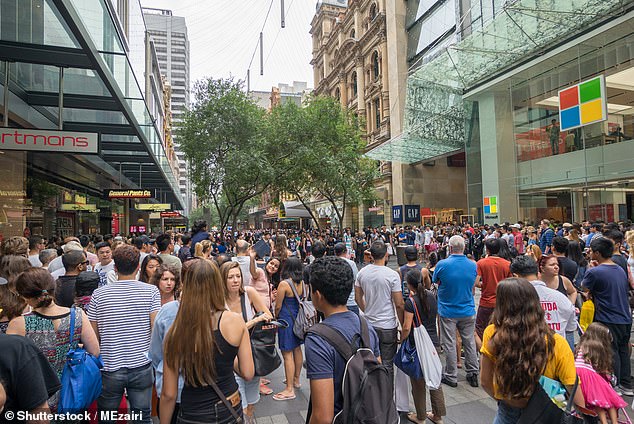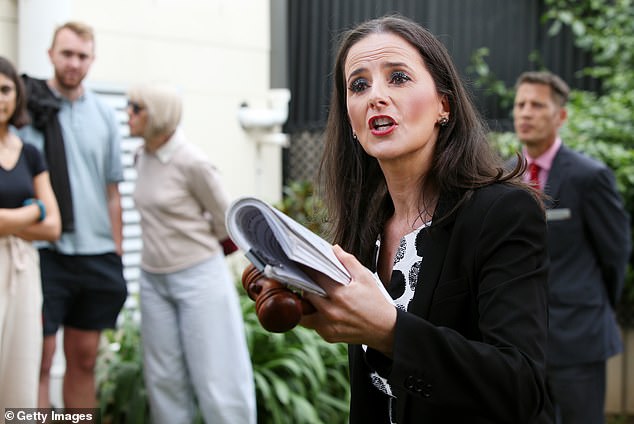AMP chief economist Shane Oliver declares that high immigration is to blame for Australia’s housing crisis – and warns numbers need to be capped now before it’s too late
A top economist has called for a cap on the number of new migrants arriving in Australia so the housing market can recover.
AMP chief economist Shane Oliver told the AFR Property Summit that the root cause of Australia’s housing crisis was record high immigration.
Dr. Oliver said immigration levels in Australia since 2005 have been “well above” the supply level the country actually needs.
Therefore, immigration-driven population growth had to reflect the market’s ability to supply enough completed housing, the economist said.
“If you go back to the recession of the early 1990s, immigration levels were about 120,000 a year,” Dr. Oliver said at the summit on Tuesday.
‘Then they rose to 250,000 to 260,000 per year. So you really gained 150,000 extra inhabitants during that period.
‘But if you look at the completions of homes, they only really increased when we had a short boom in apartment construction between 2015 and 2018.’
AMP chief economist Shane Oliver (pictured) told the AFR Property Summit on Tuesday that the root cause of Australia’s housing crisis is record high levels of immigration.

Dr. Oliver said immigration levels in Australia since 2005 have been ‘well above’ the level of supply the country actually needs (pictured, Sydney’s Westfield shopping centre)
‘And that’s the real problem here. We pump people into the economy and then we all go ‘surprise, surprise,’ housing prices are expensive,” he continued.
Dr. Oliver said this was the root of Australia’s housing affordability problem.
“I think we need to match those immigration levels with the ability of the real estate market to supply new real estate and give each year an opportunity to eliminate that cumulative undersupply,” he said.
Other experts who attended the summit echoed Dr. Oliver.
Respected real estate analyst Louis Christopher called for a two-year cap of 90,000 new migrants as the housing market caught up.
The director of SQM Research said modeling shows that if immigration were limited to historic levels, Australia’s rental crisis would end by mid-2025.
Nearly 1.5 million migrants are expected to arrive in Australia over the next five years, with the population growing by 1.9 percent last year – one of the highest in the developed world.
Dr. Oliver has previously argued that immigration-driven population growth is making Australians less productive, hindering home ownership and fueling inflation.
“Very strong population growth with inadequate response to infrastructure and housing supply has led to urban congestion and poor housing affordability, contributing to poor productivity growth,” he said.
The economist also argued that high population growth meant investors were buying homes for capital gains, to take advantage of a housing shortage, rather than putting their money into new business ventures or stocks.
“Increased speculative activity around housing diverts resources from more productive uses,” he said.

A top economist has claimed that high immigration is the root cause of Australia’s housing crisis, preventing Australians from owning their own home (pictured, a Sydney auctioneer)
Australia’s annual net overseas migration level has been consistently in the six figures since 1999, with the exception of the Covid pandemic in 2020 and 2021, when skilled migrants and international students were included.
Dr. Oliver said unless productivity growth returns to 1990s levels, inflation would remain higher for longer, but feared both major political parties would be reluctant to liberalize labor laws.
“After almost two decades of policy drift, slowing productivity growth is weighing on living standards growth and sustainable real wage growth,” he said.
‘The political will for the kind of economic reforms needed (particularly in taxation and labor markets) for a return to 1990s-style productivity growth seems unlikely.
‘This in turn makes the RBA’s job of reducing inflation a little more difficult and will limit investment returns over the medium term.’
